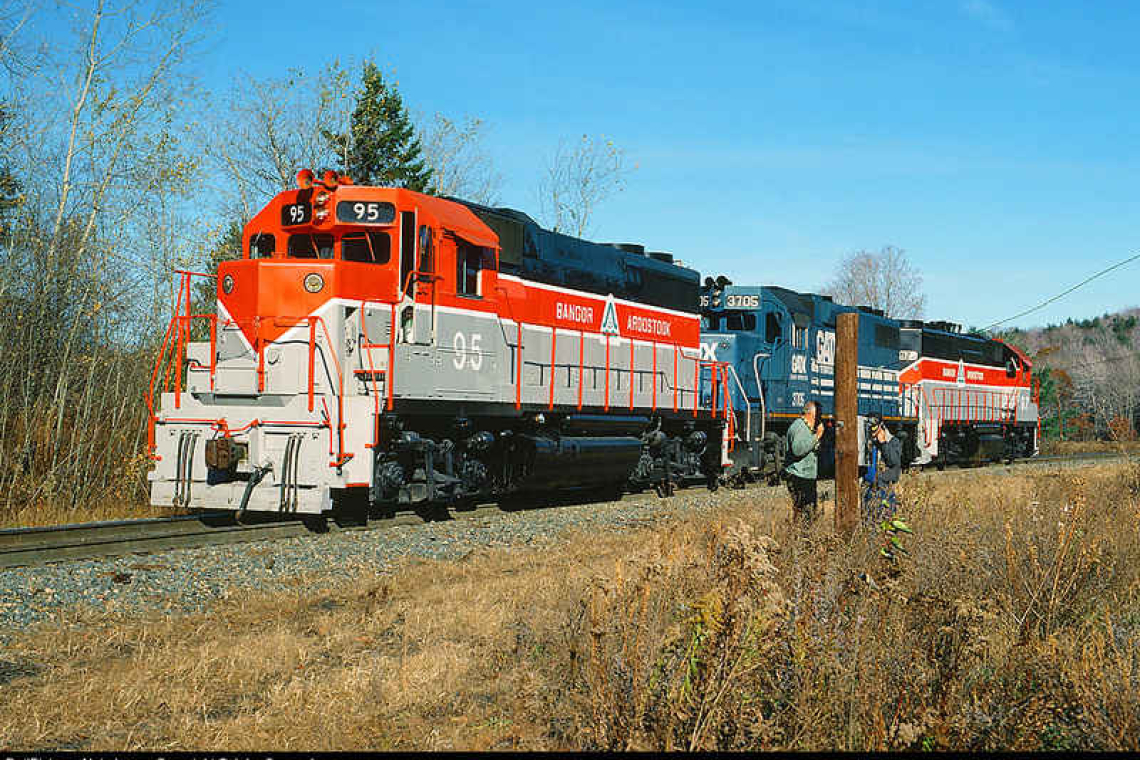Engine 95 was crowned king of Maine. 95 was an EMD (Electro-Motive Diesel) GP38-3 Diesel Locomotive built in 1967 and first owned by the Missouri Pacific Railroad. It sported the number 363. It was sold and moved east to Maine to haul potatoes, paper and lumber for the Bangor and Aroostook Railroad. 95 was special. I t was given the title Crown of Maine, which was painted on its side, and in addition to its regular duties of hauling freight, it was used for publicity photos. Yep. Maine considered Aroostook county their crown. After all, Maine won Aroostook county or at least the land that would be known as Aroostook in the Aroostook war with Canada. It was a brutal fight with just one death. A bear! No records could be found to determine which side if either had a BBQ and ate the bear meat. Aroostook county is the land at the very tip of Maine. It is surrounded by water on three sides. The land is fertile and for years the area supplied lumber.
No one is sure who coined the term Crown of Maine, but Aroostook sat on the top of Maine and thus became known as the crown. The Crown of Maine is also a diesel locomotive. But wait. A crown is a round ornamental decoration usually worn by monarchs to display their wealth, power and position. Engine 95 fulfilled those duties for the BAR. The Bangor and Aroostook Railroad was a rather small railroad that served Maine. The company was incorporated in 1891 when it was formed by combining the Bangor and Piscataquis Railroad and the Bangor and Katahdin Iron Works Railway. BAR featured more than 800 miles of track from Bangor to Van Buren. The Bangor and Aroostook Railroad was so small it was forced to change its reporting name. It started out with steam engines labelled B&A. But in 1920, they switched to BAR so as not to be confused with the Boston & Albany. The original 95 was an Alco Steam engine built in 1911 It was upgraded in 1918 to be super-heated and eventually scrapped in 1951 after 40 years of service. Bangor and Aroostook Railroad workshops were renowned at rebuilding, repairing and just plain keep the trains running.
Many of the old BAR Locomotives were purchased used. Despite the age, BAR maintained the equipment so well that many became museum pieces. The Bangor & Aroostook didn’t purchase its first diesels until 1947. They bought EMD F3s. Once BAR started the switch to diesel, they moved quickly buying mostly used power. Their last steam operations finished in 1949. BAR seemed to almost collect and restore old engines. It appears BAR used the services of Helm Leasing Company (HLCX) to find used locomotives. The leasing Company purchased Electro-Motive Diesel (EMD) E7As for passenger service, NW2 yard switchers, F3A-B-A multiple units for heavy freight service, and even BL2s for branch line freight service in the late 1940s. BAR started dieselization with F3B units and then added EMD GP7s and EMD GP9s. The railroad kept their older diesels in good shape for a long time.
Nearly 10 years passed before BAR added GP38s to their rooster in the late 1960s. Ironically, Engine 35 does not appear on all lists of BAR engines. Several lists stop at 94. The Bar had eight GP-38 on its rooster numbered 81 -88. The first two were built in 1966, the rest in 1967. Then in 1983, BAR added numbers 90 to 94 with 90, 91 and 92 units built in 1967 and the last two in 1969. But we know 95 was real. The locomotive shows up in many pictures and get this: Colour slides of the engine are still available on E-bay. While Engine 35 was the Crown of Maine, BAR was also very popular under the Christmas tree. In the 1950s, copies of their red, white, and blue “heated” HO scale boxcars hit the toy market, and sales sky rocketed. While many railroads had refrigerated boxcars, BAR cars were heated. BAR shipped potatoes in the winter.
The cars had to be heated so the crop would not freeze and be spoiled. Ironically, it was the heated cars that led to the downfall of BAR. During the winter of 1969 to 70, filled boxcars were sent to the Penn Central Transportation Company interchange service to be forwards across the country. The cars sat full. No one refuelled the heaters. The crop froze and was spoiled. Everyone lost money. Next season, the Maine farmers that survived the financial lost but were able to continue farming shipped their goods by truck. At its height, potato shipping was almost 50 percent of the BAR income. BAR was purchased by rail holding company Iron Road Railways in 1995. Yet nearly 30 years after BAR was sold, toy boxcars are still for sale and with the red, white and blue colour scheme, they are very popular. “Crown of Maine” is the registered trademark of Aroostook County Tourism since 2004, according to Jacob Pelkey the Tourism Developer for Aroostook County.







